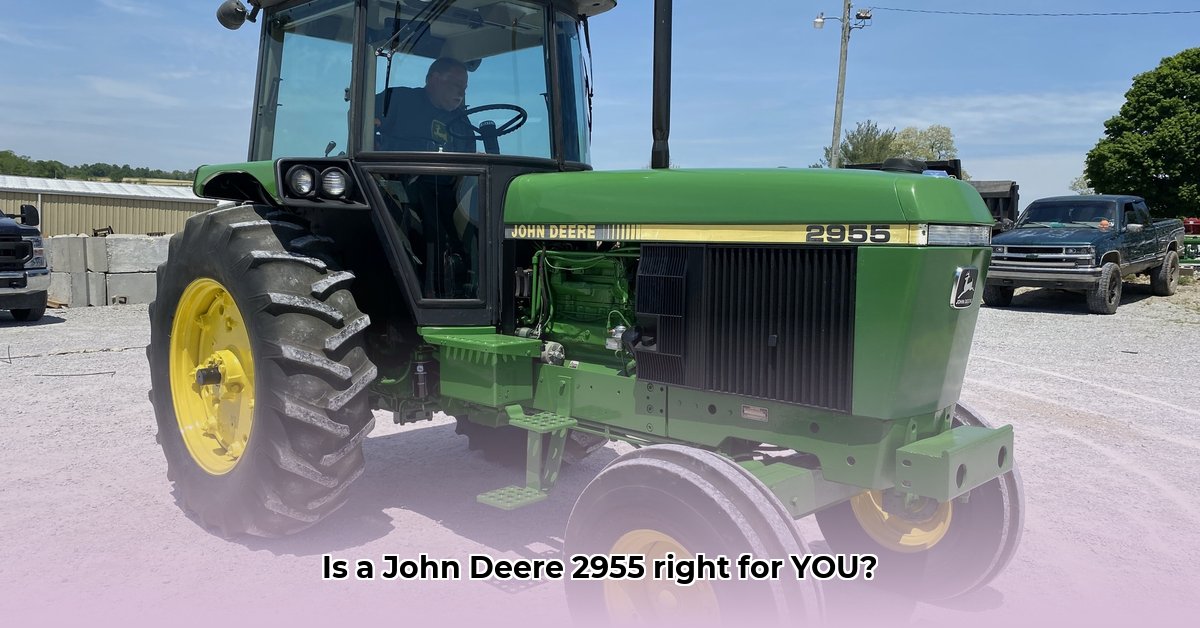
This comprehensive guide helps you navigate the market for used John Deere 2955 tractors. We'll cover pricing, condition assessment, maintenance, parts sourcing, and buying/selling advice, empowering you to make an informed decision. If you're experiencing starting issues, check out this helpful troubleshooting guide: John Deere Starting Issues.
Understanding the John Deere 2955 Tractor Market
The John Deere 2955, produced from 1987 to 1992, remains a sought-after workhorse. Its price, however, varies widely—from a few thousand dollars to over $40,000. Several factors influence this range, mirroring the used car market. A well-maintained, low-hour tractor with desirable features commands a higher price. Location also plays a significant role; high-demand areas naturally inflate prices.
Did you know? The condition of a used John Deere 2955 can influence its value by as much as 50%, highlighting the importance of a thorough inspection.
Price Range Estimates (USD): These are rough estimates based on observed market trends and should be considered a starting point only.
| Price Range | Description |
|---|---|
| $7,750 - $15,000 | Lower end; likely requires significant repairs |
| $15,000 - $25,000 | Average condition; may need some maintenance |
| $25,000 - $40,000 | High-end; excellent condition or desirable features |
Thoroughly Inspecting a Used John Deere 2955 Tractor
A meticulous inspection is crucial before purchasing. Consider it a pre-purchase health check for your tractor. Here's a step-by-step guide featuring key inspection points:
Step-by-Step Inspection Guide
Engine Assessment: Listen for unusual noises (knocking, ticking, rattling) indicating potential problems. Check for leaks (oil, coolant, fuel), and examine for corrosion, especially around the battery. A clean engine compartment suggests better maintenance.
Transmission Inspection: Shift through all gears (forward and reverse) checking for smooth operation. Grinding, whining, or difficulty shifting signifies potential transmission problems—often expensive to repair.
Hydraulic System Evaluation: Test the three-point hitch lift; it should operate smoothly and quickly. Hesitation or slow response suggests potential problems. Carefully inspect all hydraulic lines for leaks.
Three-Point Hitch Check: Ensure the hitch raises and lowers smoothly through its full range of motion. This is crucial for efficient and safe operation.
PTO (Power Take-Off) Examination: Verify that the PTO engages and disengages smoothly without any unusual sounds.
Tire Condition Evaluation: Check tread depth on all tires – insufficient depth impacts traction and safety. Look for cracks, bulges, or other damage.
Electrical System Test: Turn on all lights, gauges, and indicators to confirm functionality. Check the battery terminals for corrosion and a secure connection.
Exterior Body Check: Inspect the body for dents, rust, or damage. While cosmetic, these can hint at overall care and maintenance history. Request maintenance records for valuable insight.
Pro Tip: Engaging a qualified mechanic for a pre-purchase inspection is highly recommended, mitigating potential costly surprises.
Understanding the John Deere 2955's Capabilities and Maintenance
The John Deere 2955 delivers approximately 97 horsepower, suitable for various farm tasks. However, regular maintenance is crucial for longevity.
Essential Maintenance Schedule:
- Oil changes: Adhere to the owner's manual recommendations. This is fundamental for engine health.
- Filter replacements: Regularly replace air, fuel, and hydraulic filters to prevent contamination.
- Fluid level checks: Maintain correct levels of engine oil, coolant, transmission fluid, and hydraulic fluid.
- Belt inspection: Regularly inspect belts for wear and tear, replacing as needed to avoid breakdowns.
Common Issues:
Given its age, be aware of potential issues like hydraulic leaks, electrical problems, and transmission difficulties. These repairs can be expensive, underscoring the importance of a thorough inspection.
Finding Parts for Your John Deere 2955
Sourcing parts for older tractors can be challenging. Here's a prioritized approach:
- John Deere Dealers: Your primary source; while some parts might be discontinued, they are your best starting point.
- Aftermarket Suppliers: Numerous companies offer replacement parts—compare prices and reviews.
- Online Marketplaces: Explore specialized agricultural equipment sites and general online marketplaces.
- Used Parts Suppliers (Salvage Yards): A cost-effective option, but inspect used parts thoroughly before installation.
Practical Advice for Buyers and Sellers
For Buyers: Don't rush. Thoroughly inspect, get a professional assessment if needed, and negotiate based on your assessment and market value.
For Sellers: Be transparent about the tractor's condition. Accurate documentation and maintenance records build buyer confidence. High-quality photos and a detailed description are essential. Thorough cleaning significantly enhances visual appeal.
Did you know? A well-presented listing with detailed photos and accurate descriptions can increase your selling price by at least 10%.
Conclusion
Purchasing a used John Deere 2955 can be worthwhile, offering years of reliable service. A systematic approach—thorough inspection, realistic pricing, and open communication—is key to a successful transaction. Remember, a well-maintained John Deere 2955 is a valuable asset.